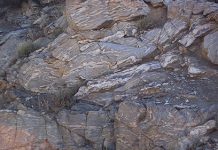
Story and Photos by Jim Landon
Biggs Junction, Oregon, is a well-known producer of some of the finest picture jasper in the world. Any Northwest rockhound who has been around for a while knows what Biggs, Blue Biggs, China Hollow, and Deschutes jaspers look like, and many have specimens gracing their collections. In the past, I’ve led Rock & Gem readers on a virtual exploration of the areas where the above varieties of jasper are found, and now I want to share with you another of my favorite locales, the Biggs triangle area.
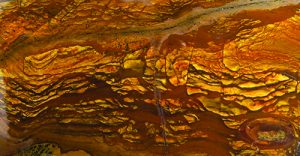
In the January 2012 issue of Rock & Gem, I wrote about a visit our Yakima Washington club made to China Hollow, where we dug in two pits on land owned and mined by Don Hilderbrand. In the March 2015 issue of Rock & Gem, I wrote about Biggs jasper, Blue Biggs jasper, and Deschutes jasper, how each formed, and how to differentiate one from another. I’ve included a couple of photos in this article that also illustrates the differences. The area where the different jasper outcrops occur is called the Biggs triangle. The area extends from the Deschutes River’s mouth — where Deschutes jasper was mined back in the day by Hoot Elkins — to Rufus Oregon, which is east of Biggs Junction, and then on to China Hollow where Don Hilderbrand has been mining jasper and agate for many years.
The jasper deposits are present at several locations where erosion from multiple flows of the Columbia River Flood Basalts has exposed the deposits within walls of canyons. One notable occurrence is in the road cut south of US Hwy 97 and south of Biggs Junction, where both classic Biggs and Blue Biggs appear. The Biggs jasper deposits at these localities formed when low lying marshes and shallow ponds were inundated and buried by pulses of lava that emanated from fissures in southeast Washington and northeast Oregon.
Looking Back at Biggs Mining History
During the rockhounding heyday of the ‘50s, ‘60s, and ‘70s, several active commercial mining ventures were going in the Biggs triangle area with each locality producing material that had distinctive patterning. Over the years, production at most of these localities pretty much ceased as miners and miner/rock shop owners in the area died, and landowners denied access to quarries, or deposits were mined out. For many years the only material that has made its way to market has come from old private collections, long-forgotten stashes, or production at the China Hollow locality.
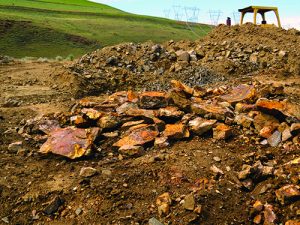
Since our Yakima Washington club’s trip to the area years back, I’ve kept in contact with Don Hilderbrand of China Hollow fame. In early May of 2020, during the onset of the COVID-19 pandemic in the U.S., I received a message from Don inviting me to check out a new mine being developed in the area by a man named Jay Carlson. It seems the man assumed a management position for both Don’s China Hollow operation and this new locality near Rufus Oregon he named Beers Mountain. I was overjoyed for the opportunity to check out what was to me, a new locality. So pandemic or no, this was an opportunity I couldn’t pass up.
Plans were set for us to get together in May 2020. On the appointed day, my wife Kerry and I piled in our pickup with our two rockhound labs Schmedley and Charles de Gaul, and headed down to Biggs Junction and then to Rufus, with face masks and hand sanitizer packed. We decided to meet at a property Jay had purchased in Rufus that he had hopes of establishing as a rock shop. Jay told me to look for a row of China Hollow decorative boulders he had placed along the boundary of his property.
The trip down to Rufus from our home in Cowiche, Washington was pretty uneventful, except for a howling wind blowing east up the Columbia River Gorge. As a results, above the Dalles Dam we saw whitecap-topped waves that defied the swift current. Driving into the Columbia River Canyon to the bridge that connects Washington with Oregon at Biggs Junction always offers a spectacular view of basalt’s enormous layer cake flows that had buried the Miocene Age landscape under thousands of feet of black volcanic rock.
Rockhounding Report
When we pulled up to Jay’s property, both he and Don were there. After exchanging pleasantries, we left Rufus and headed to the mine site, passing through a locked gate. The Beers Mountain Mine is on private property and access is only allowed with Jay present. After driving a short distance, we topped out at the mine where Jay had opened a small area he had been exploring. As soon as we left our vehicles, we were buffeted by the 40-plus mile-per-hour wind that rocked Mobie, my great white whale truck, back and forth. The wind turbines on the Washington side of the river were going flat out. Without governors to control their speed, they for sure would have blown themselves apart.
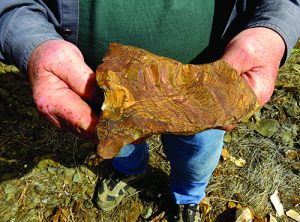
Although this locality was known to the old-timers, it had not been explored for decades. Jay took me to an area he had been working, so I could get a look at the jasper seam and the material he had been digging. There were chunks of jasper lying all over the place. The rain that had fallen in the area recently had washed the dirt off the exposed material, making it easy to spot. It was an incredible sight to behold. I was surprised to see that the jasper and agate seam at this locality was only capped by a few feet of weathered volcanic rock. At other Biggs jasper localities I’ve visited, hundreds of feet of tough basalt usually cover the seams, providing only cross-sections of jasper exposure, making digging access both difficult and expensive. Jay had used a CAT to remove the basalt layer down to the jasper seam. Upon contact, the jasper’s surface was a dark rusty red to orange, indicating the presence of iron oxide. The actual jasper layer varied in thickness from several inches to over two feet.
Jay has been using a small track hoe to work the jasper layer. It was breaking out in chunks of varying sizes, with the larger pieces weighing several hundred pounds. Like the Biggs jasper that I have seen at other quarries in the are, the Beers Mountain material appeared as thinly banded layers of mud later buried and “cooked” by encroaching red hot basalt. What makes this jasper unique when compared to other types of Biggs is its color and delicate banding. Color wise it somewhat resembles deschutes jasper but is generally more orange. The patterning on this material is unique, however. Whereas the other types of Biggs jasper tend to have larger and more open patterns with wider bedding lines, the Beers Mountain jasper reminded me of high quality thinly banded slate. On some of the pieces, black dendrites were also showing.
There is also some evidence that after the mud had been silicified, it fractured, which shifted the patterns, and it re-healed. The nature of the mud was such that once it hardened, its fine-grained texture matched high-end porcelain-type jaspers. Jay told me that after each day of mining, he loads the jasper dug that day into a dump truck and hauls it out of the mine to a safe location for sorting and processing. He also said the site would be reclaimed after he has finished mining.
Looking Ahead
I asked Jay what his plans were for the quarry and was happy to hear that he is planning on hosting rock clubs at China Hollow and Beers Mountain as well as having material sent to processors for creating spheres, beads, and other objects. He added that he would like to offer multiple options to clubs, such as a two-deposit one-day dig, visiting China Hollow in the morning, and Beers Mountain in the afternoon. China Hollow has two active quarries, with each having a different kind of material to collect. Another option would be to visit China Hollow one day and then Beers Mountain the second. A third option is to collect at one or the other. Jay said rock from either locality would be sold by the pound and that collectors can pay either by cash or check. He is interested in hosting club groups rather than individuals or families.
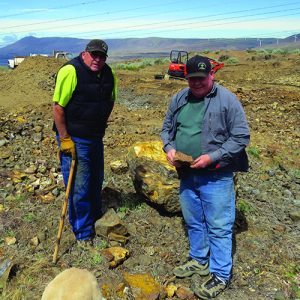
After we finished our quarry tour, Jay took Kerry and me over to his house in Rufus. At the time, he was finishing a place to cut rock using a drag saw that once belonged to Don. The two men are also designing another drag saw to use in cutting boulders from both the Beers Mountain quarry and China Hollow.
We also visited Don’s home in the middle of the wheat field country between Rufus and Wasco. During this visit, we saw Don’t personal collection. The spheres in his collection, made by Johnny Richardson, of Richardson’s Rock Ranch, are amazing. The last stop of our visit was Don’s shop in Wasco, which included the set-up of a cutting room featuring rock saws of various sizes. It looks like Don and Jay have big plans for the future.
Upon our departure, Jay and Don gave me a few chunks of the Beers Mountain material to cut when I got home. I discovered a few things when cutting it. The jasper is hard, fracture free, and has a definite texture that runs parallel to the bedding plane. When it is cut perpendicular to the bedding plane, the pattern tends to show very thin lines that resemble sheets of paper, in a repeated manner. The best pattern I found occurs when I cut parallel to the bedding plane. The pattern is much tighter than any other kinds of Biggs jasper I have worked with in the past.
Another characteristic that makes it completely different from any of the other kinds of Biggs jasper is the area in the core of the slab that is charcoal gray with a different pattern from the rest of the slab. When Don wheeled the slab out of his shop strapped to a dolly, my heart skipped a beat, and when he poured water on it, that simple act took my breath away. There was no doubt that rock was going home with me.
I plan to use a MK 1503 rock polishing kit I recently ordered to polish the slab.
To learn more and discuss a possible club trip to China Hollow, Beers Mountain, or both, Jay can be contacted at shermancountyrocks@gmail.com.


